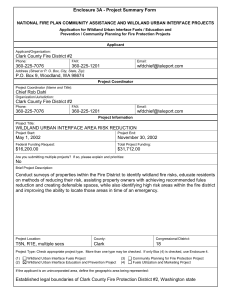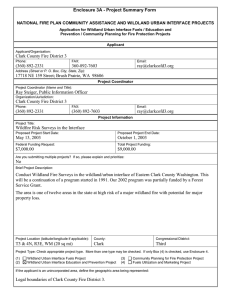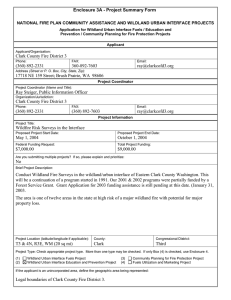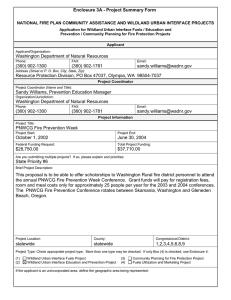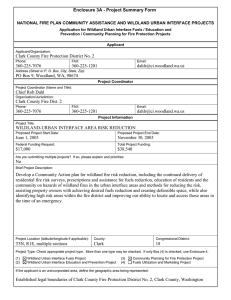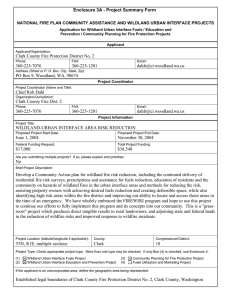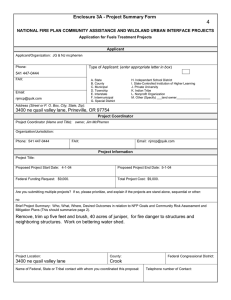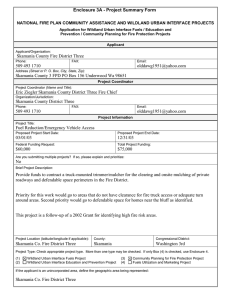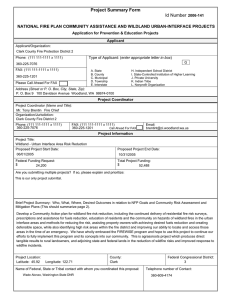D
advertisement
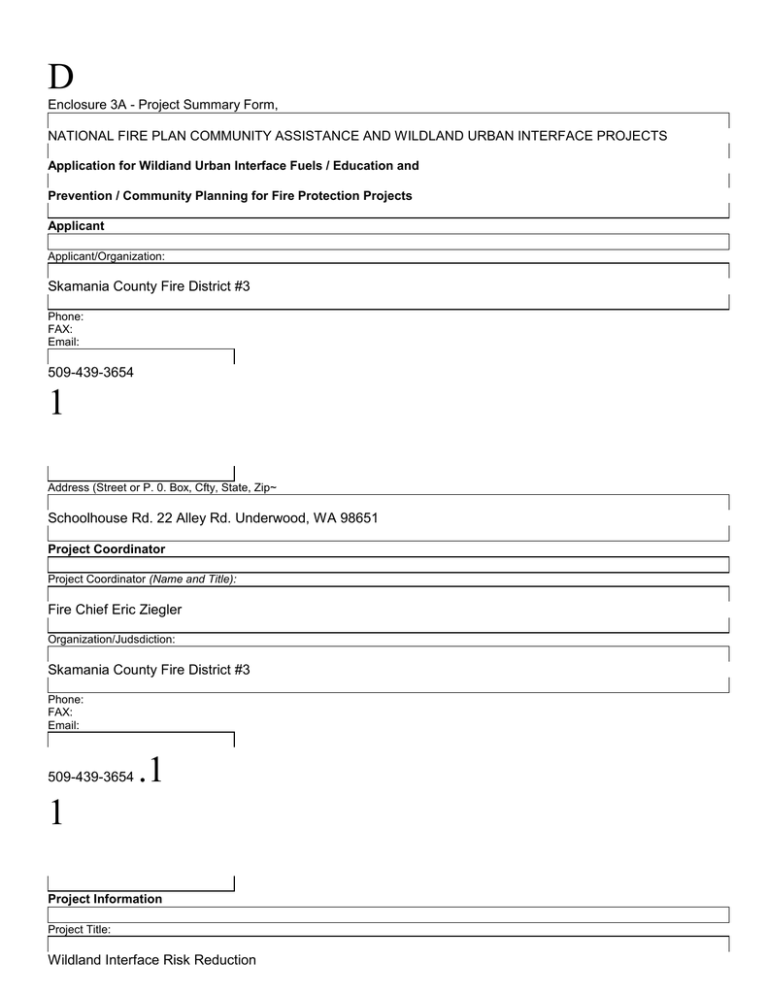
D Enclosure 3A - Project Summary Form, NATIONAL FIRE PLAN COMMUNITY ASSISTANCE AND WILDLAND URBAN INTERFACE PROJECTS Application for Wildiand Urban Interface Fuels / Education and Prevention / Community Planning for Fire Protection Projects Applicant Applicant/Organization: Skamania County Fire District #3 Phone: FAX: Email: 509-439-3654 1 Address (Street or P. 0. Box, Cfty, State, Zip~ Schoolhouse Rd. 22 Alley Rd. Underwood, WA 98651 Project Coordinator Project Coordinator (Name and Title): Fire Chief Eric Ziegler Organization/Judsdiction: Skamania County Fire District #3 Phone: FAX: Email: 509-439-3654 .1 1 Project Information Project Title: Wildland Interface Risk Reduction Project Start: Project End: May 1, 2002 October 1, 2002 Federal Funding Request: Total Project Funding: $8,000 $10,069 Are you submftting multiple projects? If so, please explain and prioritize: No Brief Project Description: Conduct surveys of properties within Skamania County Fire District #3 to identify wildland fire risks, educate residents on methods of reducing their risk, identify high risk areas within the fire district and improve the ability to locate those areas in time during an emergency. The district is one of twelve areas in the state at high risk of a major wildiand fire with the potential for major property loss. Project Location: County: Congressional District: T3N, Rl OE, multiple secs (25 sq) Skamania Third Project Type: Check appropriate project type. More than one type may be checked. If only Box (4) is checked, use Enclosure 4. (1) E] Wildland Urban Interface Fuels Project (3) E] Community Planning for Fire Protection Project (2) Xr-1 Wildiand Urban Interface Education and Prevention (4) [] Fuels Utilization and Marketing Project . Project If the applicant is an unincorporated area, define the geographic area being represented: Established legal boundaries of Skamania Fire District #3 includes Underwood,Mtn. & Northwestern Lake. Enclosure 3B (Page 1 of 3) - Project Narrative Description Applications for funding must include a narrative response that describes the proposal. Please do not submit responses longer than one page, single !Eace, 12;gitch font. Address these 0 project location 0 project income items as 0 project implementation 0 project time frames applicable: 9 anticipated outcomes 0 specify types of activities and equipment used measures and reportmg * amount or extent of actions (acres, number of homes, etc) partners 0 envirommental cultural and historical resource requirements Resi)onse: The entire area encompassing Fire District #3 is located in the forested Cascade mountain range boarding the Columbia River Gorge. The area is mostly under private ownership and varies in accessibility. The area has many homes tucked away amongst the trees, some with very poor access and many with no visable addresses. The area is subject to strong west winds in the summer. There is an urgency to inform homeowners of the risks and what they might do to limit property damage and survive a major wildfire. The project will allow our department to start a long term program at educating property owners in the best ways to reduce their risk, define defensible space and change attitude that it can't happen here. The catastrophic fire events over the past few years have heightened the need to inform the public of the risk of wildfire and educate them on what they might do to improve their chances for survival in the event of a fire. It's time to be proactive in reducing wildfire risk--this type of education and implemenation can make a difference. This area is protected with an entirely volunteer fire fighting force, with limited resources, staff, fimding, training and already a high level of service demand. The project would require hiring two temporary seasonal employees to carry out this project during the summer of 2002. The goal is to contact between 300-400 households over the course of the project year. There is also an opportunity to partner with the Washington Department of Natural Resources and U.S. Fish and Wildlife Service. The primary objective of this project is public education, primarily on the means homeowners can use to protect their property from wildfire and to prevent a housefire from spreading into the forest lands. Secondary objectives include the opportunity for the fire district to develop a more comprehensive vision as to the problem areas in the district. Thirdly it is hope that increased citizen interest in fire protection will hopefully increase participation in the department. Factors relative to evacuation, resources and property values involved will be critical in the development of an overall pre-fire plan. The most important benefits and the ultimate objective of the project is saving lives and preventing loss of property and resources. Enclosure 3B (Page 2 of 3) - Project Evaluation Criteria AWlications for fimding must include namtive responses that address the following four criteria. Within each criterion, subcriteria are listed in descendin2 order of inwortame. Limit vour resnonses to the anas nrovided. Response: This project, the first for our fire district, will be based on similar efforts in other districts that have proven to be very successful. We are committed to making this a long-term project and are working towards identifying and developing resources to do so. The major emphasis of this program is to reduce fire risk and property loss in the wildland/urban interface area of Fire District #3, an area of approximately 25 square miles. This area has been designated, by the State, as I of 12 areas in Washington at high risk of a major fire with potentially major property loss. Identifying and reducing fuels around homes, more fire resistant construction, better access and address signing will lead to better fire protection for homes and resources of the land. It also reduces chance for fire spread to nearby state and federal lands. This year's project goal is to survey 400 homes and make recommended improvements. We would work to continue the program in the future for additional home surveys and monitoring of improvements that have been made. A. B. C. D. E. F. A. B. C. Describe how the proposal promotes reduction of risk in high hazard areas or communities. Describe how the proposed project benefits resources on federal land or adjacent non-federal lan~ or how it protects the safety of communities. To what extent does the project implement or create a cooperative fuels treatment plan or community fire strategy (include evidence of the plan if it already exists)? Explain to what extent the affected community or proponent has been involved or plans to involve the affected community in a qualified fuels education program (e.g., FIREWISE). Explain how the proposal (a) leads to, enhances or restores a local fire-adapted ecosystem, and/or (b) mitigates or leads to the mitigation of hazardous fuel conditions. How will the proposed treatments be maintained over time? How would the proposal invrove or lead to the improvement of the local economy in terms ofjobs and sustainable economic activw. How many jobs are expected to be created or retained and for how long (please distinguish between essentially year round and seasonal jobs)? To what extent will this project be offered to serve as a model for other communities? Will biomass or forest fuels be utilized; if so, in what manner and how much? Response: This project hopes to create a marked improvement in the creation of defensible space around homes located within this interface area, primarily due to the direct opportunity to educate, inform, demonstrate and involve the homeowners in their own personal safety. Similar projects in our neighboring districts have been met with great appreciation from property owners and have demonstrated success in the creation of safer communities. This effort would be the first in this area and could serve as a model for additional communities and counties. Two local jobs will be created for approximately three months. Students have been used in other similar programs and have been proven to be effective in conducting surveys. Based on the estimated population in the fire district and adjacent interface areas we estimate that 5,000 people will directly and indirectly benefit from this project. It is also hoped through the public education and outreach efforts interest in serving the community as a volunteer in the fire department will be a side benefit. I- Enclosure 3B (Page 3 of 3) - Project Evaluation Criteria community organizations. List the cooperators. Resi)onse: Guidelines developed by State and Federal agencies, including the Pacific Northwest Interagency Fire Prevention Group will be used for the surveys. Tlle expertise of these groups in developing these necessary guides for fire safe homes and communities is the technology we transfer to the private land and homeowner. The success of this program in helping to prevent the spread of fire, and reduce fire loss, can have an immense effect on the resources of our, and all other local fire jurisdictions including State and Forest Service. The Underwood Community Council will assist in outreach activities by providing forums to disseminate information about the project. The program is a partnership between the Fire District and local taxpayers and homeowners. We provide valuable resource information and they implement the program either on their own or in cooperation with others. A. exists. B. A. B. C. Describe how this project implements a local intergovernmental strategy plan, or creates such a plan. Describe the plan if it already Explain the level of cooperation, coordination or strategic planning among federal, state, tribal, local government and To what extent have interested people and connnunities been provided an opportunity to become informed and involved in this proposal? Describe the extent of local support for the project, including any cost-sharing arrangements. What are the environmental, social and educational benefits of the project? i Response: This is a program that has been successfully implemented in other fire districts in adjacent counties. The value of this program has been demonstrated in these areas. Our fire district needs to begin to implement and look for ways to continue in the future. This project has been discussed at Community Council meetings. Homeowners have been concerned for many years about the high fire danger risk and want to learn how to reduce this risk. Our outreach will consist of news releases and newsletters to homeowners within the District's boundaries. Our intent is to reach not only local media but also Portland based media to inform the public about the importance of the program and the need for homeowners to be involved in helping protect their communities from fire. Through outreach the public will learn about the benefits of this progatn and protection of human lives and the environment. In-kind contributions consist of volunteer time estimated at 90 hours, for program coordination, media contacts, homeowner contacts, and follow-up after the survey team is finished. It also consists of clerical, benefits, travel, uniforms, printing, vehicle fuel, supplies and vehicle insurance. Enclosure 3C - Project Work Form Tasks Time Frame Responsible Party Media Contacts/Public Meeting Recruit and Hire Training June 2002 June 2002 June 2002 Begin Field Surveys Progress Review/Public Meeting June 2002 July 2002 Complete Field Surveys & Reports Release Survey Team Follow-up/Evaluation Report to Community/Public Meeting/ Media Contacts August 2002 August 2002 Fire Clerk/Underwood Council Chief Ziegler Fire Department/DNR/Clark Count Fire District #3 Survey Team Chief Ziegler/tJnderwood Council Survey Team Chief Ziegler District Personnel Chief Ziegler/Underwood Council September 2002 Enclosure 3D - Project Budget Ott Personnel 600 hrs @ 10/hr 90 hrs @10/hr Subtotal 6,000 6,000 900 -------------- -------------------------------------- ---------- Fringe Benefits SS Medicare 6,000 900 900 -- ---------------- ------------------------ ------------------------- --------- !~9900 119 119 Subtotal 119 -------------------------------------- ------- ------------------------- --------- ilg --------Travel Vehicle Insurance/Fuel 400 Vehicle Rental 2,000 Subtotal 2,000 400 2,400 -------------------------------------- -------- -- ------------------------------------Equipment Subtotal 400 2,000 ------------------------- ------------------------------------------------------------------------------------------------------ ------------------------------------------------- Supplies Uniforms Materials/Radio Use/Printing Subtotal ------------------------------------------------- Contractual Subtotal 200 450 200 450 650 650 - ------------------------ ------------------------------------------------------------------------------------------------------ ------------------------- -------------------------------------- - Other Subtotal -------------------------------------- ------ Total Costs Project (Program) lncomis~ 8,000 ----------------------------------------------------------------------------------------------------- 2,069 ------------------------- 10,069__ ------- ' Program income is the gross revenue generated by a grant or cooperative agreement supported activity during the life of the grant. Program income can be made by recipients from fees charged for conference or workshop attendance, from rental fees earned from rentmg out real property or equipment acquired with grant or cooperative agreement funds, or from the sale of commodities or items developed under the grant or cooperative agreement. The use of Program Income during the project period may require prior approval by the granting agency.
